


| Two pages of Wyeth
in issues 4 & 8 of |
 |
Wyeth is in issues 2 & 3 of |
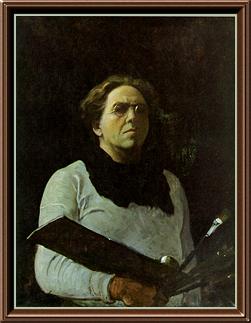 Newell
Convers Wyeth is the head of several generations of important
American artists. He was the father of Andrew, Henriette and Carolyn
Wyeth, the grandfather of Jamie Wyeth, the father-in-law of Peter
Hurd, and the list goes on.
Newell
Convers Wyeth is the head of several generations of important
American artists. He was the father of Andrew, Henriette and Carolyn
Wyeth, the grandfather of Jamie Wyeth, the father-in-law of Peter
Hurd, and the list goes on.
He was born in 1882 - the same year as Bauer, Dulac and Pogany. An inveterate "drawer" as a child, Wyeth began his formal art training very sporadically, jumping from school to school (including a short stay at the Eric Pape School) and instructor to instructor until, at age 20, he was accepted into the Howard Pyle School for the 1902 sessions.
David Michaelis, in his excellent N.C. Wyeth : A Biography, charts Wyeth's life, including his complex relationship with Pyle, through letters, interviews and a bit of speculative history. If you're a Wyeth fan and have resisted reading the book for any reason, I found it most fascinating and learned much about Pyle as well as Wyeth.
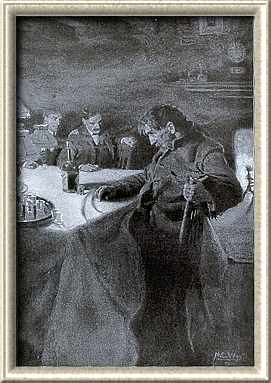 Under
Pyle's tutelage, Wyeth's innate talent blossomed. Within a year
he had his first illustration published and it was a cover
for a 1903 issue of The Saturday Evening Post. Another
early market was Success Magazine. Soon he was a regular
contributor to Harpers, McClures, Scribners
and others, and a steady feature at the Post. The image
at right is from the December 1904 issue of Scribners.
Under
Pyle's tutelage, Wyeth's innate talent blossomed. Within a year
he had his first illustration published and it was a cover
for a 1903 issue of The Saturday Evening Post. Another
early market was Success Magazine. Soon he was a regular
contributor to Harpers, McClures, Scribners
and others, and a steady feature at the Post. The image
at right is from the December 1904 issue of Scribners.
 Wyeth
was graduated from the Pyle School of Art in 1904 - which simply
meant that he no longer had to attend classes. He continued to
paint in a studio at the school for several years. He took two
trips 'Out West' to soak up the ambiance in 1904 and 1906. By
the time the March 1906 issue of McClures (frontispiece
at left) appeared, Wyeth was established as a Western Adventure
illustrator. He was much more, but a goodly portion of his early
commissions were for paintings to accompany classics like Arizona
Nights by Stewart Edward White and the original Hopalong
Cassidy yarns by Clarence Mulford.
Wyeth
was graduated from the Pyle School of Art in 1904 - which simply
meant that he no longer had to attend classes. He continued to
paint in a studio at the school for several years. He took two
trips 'Out West' to soak up the ambiance in 1904 and 1906. By
the time the March 1906 issue of McClures (frontispiece
at left) appeared, Wyeth was established as a Western Adventure
illustrator. He was much more, but a goodly portion of his early
commissions were for paintings to accompany classics like Arizona
Nights by Stewart Edward White and the original Hopalong
Cassidy yarns by Clarence Mulford.
By 1907, just four years after his first work, Outing
was touting a Wyeth Portfolio, The Indian in his Solitude.
The two outer images below are from this important group of paintings
and the center image is concurrent. You can click on each one
for a larger version and an observation about an artist whose
influence upon the young Wyeth hasn't been that well documented.
If I'm able, I like to add a little insight to the biographical
data of the artists I profile. Finding something new to say about
Wyeth wasn't easy, but nowhere have I been able to find mention
of George De Forest Brush who had a tremendous influence
on the Solitude portfolio. If you click on each
of the three Wyeth images below, you'll be able to see a Brush
painting that could easily have influenced it (as well as a larger
version of the Wyeth painting). If there were just one such comparison,
I could attribute it to coincidence, but there are many. I don't
intend to diminish in any way Wyeth's work or integrity. I simply
want to point out an influence that seems to have been missed
in the various biographies.

|

|
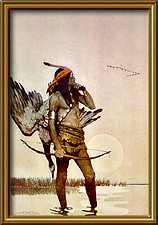
|
With the popularity of his color work came another major market that seemed to be created simply to showcase his art. The classic adventure tales of Robert Louis Stevenson had been in print since they were published. When the publisher Charles Scribner's Sons paired Wyeth with Stevenson and others, they started an industry that continues to this day. Chronologically the Scribner's Classics editions of Wyeth's work consist of::
| Treasure Island | 1911 | Robert Louis Stevenson |
| Kidnapped | 1913 | Robert Louis Stevenson |
| The Black Arrow | 1916 | Robert Louis Stevenson |
| The Boy's King Arthur | 1917 | Sidney Lanier |
| The Mysterious Island | 1918 | Jules Verne |
| The Last of the Mohicans | 1919 | James Fenimore Cooper |
| Westward Ho | 1920 | Charles Kingsley |
| The Scottish Chiefs | 1921 | Jane Porter |
| Poems of American Patriotism | 1922 | Brander Matthews, ed. |
| David Balfour | 1924 | Robert Louis Stevenson |
| The Deerslayer | 1925 | James Fenimore Cooper |
| Michael Strogoff | 1927 | Jules Verne |
| Drums | 1928 | James Boyd |
| Jinglebob | 1930 | Philip Ashton Rollins |
| The Little Shepherd of Kingdom Come | 1931 | John Fox, Jr |
| The Yearling | 1939 | Majorie Kinnan Rawlings |
Each of these contained from eight to 16 color plates, the quality of which is staggering. Scribners has reissued the series with reproductions taken from restored original paintings and we simply can't recommend these enough. And, if this weren't output enough for one man, Wyeth was wooed by other publishers to illustrate classics for them as well. So, in addition to the Scribner's series, he did the following (as well as many others that don't fall under the 'classics' heading):
| Pike County Ballads | 1912 | John Hay | Houghton Mifflin |
| The Mysterious Stranger | 1916 | Mark Twain | Harpers |
| Robin Hood | 1917 | Paul Creswick | David McKay |
| The Courtship of Miles Standish | 1920 | Henry Wadsworth Longfellow | Houghton Mifflin |
| Robinson Crusoe | 1920 | Daniel Defoe | Cosmopolitan |
| Rip Van Winkle | 1921 | Washington Irving | David McKay |
| The White Company | 1922 | Arthur Conan Doyle | Cosmopolitan |
| Legends of Charlemagne | 1924 | Thomas Bullfinch | Cosmopolitan |
| The Odyssey of Homer | 1929 | George Herbert Palmer | Houghton Mifflin |
| Men of Concord | 1936 | Henry David Thoreau | Houghton Mifflin |
 Here's
a sample (at left) of just one illustration from the Scribners
reissue of the Cosmopolitan Robinson Crusoe. Don't ask
me how that works, but they've included several titles in the
series that they didn't publish originally. I chose this image
because of the handling of the landscape aspects. Below right is the
cover image for the Brandywine River Museum catalog of his personal work, N.C. Wyeth:
Not For Publication. Compare the two.
Here's
a sample (at left) of just one illustration from the Scribners
reissue of the Cosmopolitan Robinson Crusoe. Don't ask
me how that works, but they've included several titles in the
series that they didn't publish originally. I chose this image
because of the handling of the landscape aspects. Below right is the
cover image for the Brandywine River Museum catalog of his personal work, N.C. Wyeth:
Not For Publication. Compare the two.
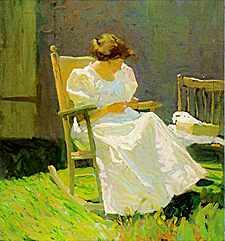 Wyeth
also wanted to be a "fine artist"–an easel painter
who would command the respect of the artistic community–whatever
that means. Whenever he applied himself to this "serious"
art, the life seems to go out of the painting. And I don't mean
just out of the figures. The grass, the chairs and background
of the "fine" art is not nearly as appealing to me as
those in the Robinson Crusoe illustration. I know that
the former is probably an oil sketch, but the approach leaves
me wondering. He could obviously do better, why was he 'dumbing
down' his skills for the critics?
Wyeth
also wanted to be a "fine artist"–an easel painter
who would command the respect of the artistic community–whatever
that means. Whenever he applied himself to this "serious"
art, the life seems to go out of the painting. And I don't mean
just out of the figures. The grass, the chairs and background
of the "fine" art is not nearly as appealing to me as
those in the Robinson Crusoe illustration. I know that
the former is probably an oil sketch, but the approach leaves
me wondering. He could obviously do better, why was he 'dumbing
down' his skills for the critics?
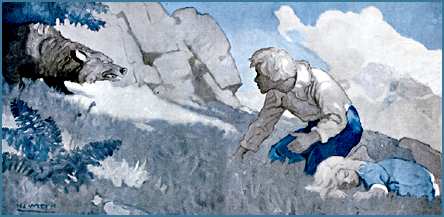
In addition to books, Wyeth was illustrating for magazines, calendars, posters and murals. He even painted maps for the National Geographic Society! Above is a two-page spread from the July 1923 issue of Hearst's International. Below is a dashing scene from a Rafael Sabatini story, The Duel on the Beach in the September 1931 issue of Ladies' Home Journal.
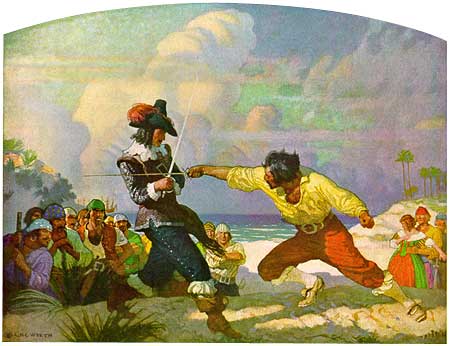
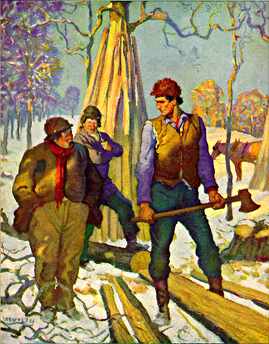 The
elusive frontispiece to 1920's Gems From Judge is at left.
Wyeth output over the years is immense. Douglas Allen and Douglas
Allen, Jr., in their N.C. Wyeth - The Collected Paintings,
Illustrations, and Murals need over 100 pages to document
the wealth of material that he created. I can't recommend this
book too highly.
The
elusive frontispiece to 1920's Gems From Judge is at left.
Wyeth output over the years is immense. Douglas Allen and Douglas
Allen, Jr., in their N.C. Wyeth - The Collected Paintings,
Illustrations, and Murals need over 100 pages to document
the wealth of material that he created. I can't recommend this
book too highly. Like many illustrators (Abbey, Brangwyn, Cornwell, etc.) Wyeth chose murals as one path to lasting fame. He painted scenes in the Missouri State Capitol building, images for several banks and hotels and for the National Geographic Society. His most ambitious project was a set of murals for the Metropolitan Life Insurance Co. He was working on these beautiful images (sample below) when he died.

Wyeth's career ended abruptly in 1945 when a car he was driving was struck by a train.
 To learn more about N.C. Wyeth, see:
To learn more about N.C. Wyeth, see:| N.C. Wyeth - The Collected Paintings, Illustrations, and Murals | Douglas Allen and Douglas Allen, Jr.,1972 Crown |
| Howard Pyle | Henry C. Pitz, 1975 Clarkson N. Potter |
| 200 Years of American Illustration | Henry C. Pitz, 1977 Random House |
| N.C. Wyeth - Not For Publication | James H. Duff, 1982 Brandywine River Museum |
| The Illustrator in America 1880-1980 | Walt and Roger Reed, 1984 Madison Square Press |
| N.C. Wyeth : A Biography | David Michaelis, 1998 A.A. Knopf |
| The Vadeboncoeur Collection of Knowledge | Jim Vadeboncoeur, Jr. 1999 |
| The Vadeboncoeur Collection of ImageS 4, 8 B&W 2, 3 | Jim Vadeboncoeur, Jr. 2002, 2004, 2006 JVJ Publishing |
|
Illustrations are copyright by their
respective owners. This page written, designed & © 2000 by Jim Vadeboncoeur, Jr. Updated 2011. |
